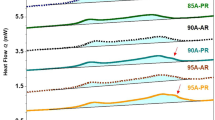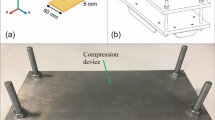Abstract
This study reports the influence of foaming temperature on morphological and thermo-mechanical characteristics of polypropylene (PP) foams prepared using two different methods of batch foaming at low saturation pressures. In the first method, involving single-step pressure-induced-foaming (PIF), the solid specimen was heated to different temperatures in a high-pressure vessel, and then saturated CO2 under pressure. Depressurization then led to foaming. In the second method, involving a two-step temperature-induced-foaming (TIF), the solid specimen was saturated with pressurized CO2 at room temperature for a specific period of time and then the CO2 laden specimen was immersed in hot glycerol bath at different temperatures for foaming. SEM micrographs of the fractured foamed specimens were employed for measurement of cell-size distribution. The average cell sizes ranged between 3 and 310 μm in specimens obtained using PIF, while in case of foams prepared by TIF, the cell sizes ranged between 30 and 70 μm. The cell sizes achieved in TIF are significantly smaller and more uniform as compared to those in PIF foams. The density (0.393–0.186 g cm−3) of PIF foams was seen to decrease with increasing foaming temperature; in contrast, in case of TIF the density remained more or less unchanged around 0.43–0.47 g cm−3 with changes in foaming temperature. The foamed specimens were characterized in uniaxial compression; the stiffness (elastic and collapse moduli) and compressive strengths of both the PIF and TIF foams were seen to decrease with increase in cell-size. The magnitude of plateau-regime stresses within the compressive stress-strain response showed strong correlation with the foam cell-wall thickness. The crystallinity of the foamed specimens was observed to decrease with increase in foaming temperatures. The thermal stability of both PIF and TIF foams in general showed improvement compared with the PP matrix.












Similar content being viewed by others
References
Gibson LJ, Ashby MF (1997) Cellular solids: Structure and properties, vol 2E. Cambridge University Press, Cambridge. https://doi.org/10.1017/CBO9781139878326
Eaves D (2004) Handbook of polymer foams, 1st ed. Rapra Technology Ltd, UK
Mills NJ (2007) Polymer foams handbook: engineering and biomechanics applications and design guide. Butterworth-Heinemann
Degischer HP, Kriszt B (2002) Handbook of cellular metals - production, processing, applications. Handbook of Cellular Metals Wiley-VCH. https://doi.org/10.1002/3527600558
Saiz-Arroyo C, De Saja JA, Velasco JI, Rodríguez-Pérez MÁ (2012) Moulded polypropylene foams produced using chemical or physical blowing agents: structure-properties relationship. J Mater Sci 47:5680–5692
Fu D, Chen F, Kuang T, Li D, Peng X, Chiu DY, Lin CS, Lee LJ (2016) Supercritical CO2 foaming of pressure-induced-flow processed linear polypropylene. Mater Des. Elsevier Ltd 93: 509–513
Antunes M, Gedler G, Abbasi H, Velasco JI (2016) Graphene nanoplatelets as a multifunctional filler for polymer foams. Materials Today: Proceedings 3:S233–S239
Antunes M, Realinho V, Ardanuy M, Maspoch ML, Velasco JI (2011) Mechanical properties and morphology of multifunctional polypropylene foams. Cell Polym 30:187–200
Lobos J, Velankar S (2014) How much do nanoparticle fillers improve the modulus and strength of polymer foams? J Cell Plast 0:1–32
Antunes M, Gedler G, Velasco JI (2013) Multifunctional nanocomposite foams based on polypropylene with carbon nanofillers. J Cell Plast 49:259–279
Zhai W, Park CB, Kontopoulou M (2011) Nanosilica addition dramatically improves the cell morphology and expansion ratio of polypropylene heterophasic copolymer foams blown in continuous extrusion. Ind Eng Chem Res 50:7282–7289
Sorrentino L, Aurilia M, Cafiero L, Iannace S (2011) Nanocomposite foams from high-performance thermoplastics. J Appl Polym Sci 122:3701–3711
Luo Y, Xin C, Zheng D, Li Z, Zhu W, Wu S, Zheng Q, He Y (2015) Effect of processing history on the rheological properties, crystallization and foamability of branched polypropylene. J Polym Res 22:1–13
Laguna-Gutierrez E, Lopez-Gil A, Saiz-Arroyo C, Van Hooghten R, Moldenaers P, Rodriguez-Perez MA (2016) Extensional rheology, cellular structure, mechanical behavior relationships in HMS PP/montmorillonite foams with similar densities. J Polym Res 23
Bao JB, Nyantakyi Junior A, Weng GS, Wang J, Fang YW, Hu GH (2016) Tensile and impact properties of microcellular isotactic polypropylene (PP) foams obtained by supercritical carbon dioxide. J Supercrit Fluids. Elsevier BV 111: 63–73
Maani A, Naguib HE, Heuzey M-C, Carreau PJ (2013) Foaming behavior of microcellular thermoplastic olefin blends. J Cell Plast 49:223–244
Xu ZM, Jiang XL, Liu T, Hu GH, Zhao L, Zhu ZN, Yuan WK (2007) Foaming of polypropylene with supercritical carbon dioxide. J Supercrit Fluids 41:299–310
Wong A, Guo Y, Parka CB (2013) Fundamental mechanisms of cell nucleation in polypropylene foaming with supercritical carbon dioxide - effects of extensional stresses and crystals. J Supercrit Fluids. Elsevier B.V. 79: 142–151
Velasco JI, Antunes M, Realinho V (2010) Foaming behaviour, structure, and properties of polypropylene nanocomposites foams. J Nanomater 2010:1–11
Istrate OM, Chen B (2011) Relative modulus–relative density relationships in low density polymer–clay nanocomposite foams. Soft Matter 7:1840–1848
Faye A, Leduc M, Brisson J (2014) Crystallization control of etherethersulfone copolymers by regular insertion of an allyl functionality. Polym Chem 5:2548
Wal A, Van Der Mulder JJ, Gaymans RJ (1998) Fracture of polypropylene : the effect of crystallinity. Polymer 39:5477–5481
Bao JB, Liu T, Zhao L, Hu GH (2011) A two-step depressurization batch process for the formation of bi-modal cell structure polystyrene foams using ScCO2. J Supercrit Fluids. Elsevier B.V. 55: 1104–1114
Li D, Liu T, Zhao L, Yuan W (2009) Solubility and diffusivity of carbon dioxide in solid-state isotactic polypropylene by the pressure - decay method. Ind Eng Chem Res 48:7117–7124
Wan F, Tran M-P, Leblanc C, Béchet E, Plougonven E, Léonard A, Detrembleur C, Noels L, Thomassin J-M, Nguyen VD (2015) Experimental and computational micro-mechanical investigations of compressive properties of polypropylene/multi-walled carbon nanotubes nanocomposite foams. Mech Mater. Elsevier Ltd 91: 95–118
Chen L, Schadler LS, Ozisik R (2011) An experimental and theoretical investigation of the compressive properties of multi-walled carbon nanotube / poly ( methyl methacrylate ) nanocomposite foams. Polymer. Elsevier Ltd 52: 2899–2909
Saha MC, Mahfuz H, Chakravarty UK, Uddin M, Kabir ME, Jeelani S (2005) Effect of density, microstructure, and strain rate on compression behavior of polymeric foams. Mater Sci Eng A 406:328–336
Kuncir EJ, Wirta RW, Golbranson FL (1990) Load-bearing characteristics of polyethylene foam: an examination of structural and compression properties. J Rehabil Res Dev 27:229–238
Moscoso-Sanchez FJ, Mendizabal E, Jasso-Gastinel CF, Ortega-Gudino P, Robledo-Ortiz JR, Gonzalez-Nunez R, Rodrigue D (2015) Morphological and mechanical characterization of foamed polyethylene via biaxial rotational molding. J Cell Plast 51:489–503
Vries DVWM de (2009) Characterization of Polymeric Foams. Master’s Thesis (MT 09.22) Eindhoven University of Technology
Iba H, Nishikawa Y, Urayama K (2016) Nonlinear stress-strain behavior of elastomer foams investigated by various types of deformation. Polymer. Elsevier Ltd 83: 190–198
Author information
Authors and Affiliations
Corresponding author
Additional information
Publisher’s note
Springer Nature remains neutral with regard to jurisdictional claims in published maps and institutional affiliations.
Rights and permissions
About this article
Cite this article
Kumar, A., Patham, B., Mohanty, S. et al. Effect of temperature on thermal, mechanical and morphological properties of polypropylene foams prepared by single step and two step batch foaming process. J Polym Res 26, 80 (2019). https://doi.org/10.1007/s10965-019-1699-3
Received:
Accepted:
Published:
DOI: https://doi.org/10.1007/s10965-019-1699-3




